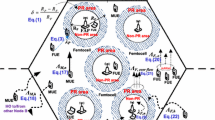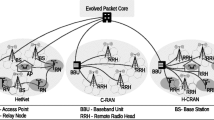Abstract
Next-generation cellular networks are expected to enable the coexistence of macro and small cells, and to support differentiated quality-of-service (QoS) of mobile applications. Under such conditions in the cell, due to a wide range of supported services and high dependencies on efficient vertical and horizontal handovers, appropriate management of handover traffic is very crucial. Furthermore, new emerging technologies, such as cloud radio access networks (C-RAN) and self-organizing networks (SON), provide good implementation and deployment opportunities for novel functions and services. We design a multi-threshold teletraffic model for heterogeneous code division multiple access (CDMA) networks that enable QoS differentiation of handover traffic when elastic and adaptive services are present. Facilitated by this model, it is possible to calculate important performance metrics for handover and new calls, such as call blocking probabilities, throughput, and radio resource utilization. This can be achieved by modelling the cellular CDMA system as a continuous-time Markov chain. After that, the determination of state probabilities in the cellular system can be performed via a recursive and efficient formula. We present the applicability framework for our proposed approach, that takes into account advances in C-RAN and SON technologies. We also evaluate the accuracy of our model using simulations and find it very satisfactory. Furthermore, experiments on commodity hardware show algorithm running times in the order of few hundreds of milliseconds, which makes it highly applicable for accurate cellular network dimensioning and radio resource management.













Similar content being viewed by others
References
Shuminoski, T., & Janevski, T. (2015). 5G mobile terminals with advanced QoS-based user-centric aggregation (AQUA) for heterogeneous wireless and mobile networks. Wireless Networks, 22(5), 1553–1570.
Ericsson (2015). Cloud RAN: The benefits of virtualisation, centralisation, and coordination. Ericsson White Paper.
Fujitsu. (2014). The benefits of cloud-RAN architecture in mobile network expansion. Fujitsu White Paper.
Kyriazis, G., & Rouskas, A. (2016). Design and operation of energy efficient heterogeneous mobile networks. Wireless Networks, 22(6), 2013–2028.
Galinina, O., Andreev, S., Turlikov, A., & Koucheryavy, Y. (2014). Optimizing energy efficiency of a multi-radio mobile device in heterogeneous beyond-4G networks. Performance Evaluation, 78, 18–41.
Peng, C., Lee, S.-B., Lu, S., & Luo, H. (2014). GreenBSN: Enabling energy-proportional cellular base station networks. IEEE Transactions on Mobile Computing, 13(11), 2537–2551.
Abdulova, V., & Aybay, I. (2015). Performance evaluation of call admission control schemes with new call reattempts in wireless cellular networks. Wireless Personal Communications, 84(4), 1–21.
Hwang, H. Y., Lee, H., Roh, B., & Kim, S. (2016). Joint resource allocation, routing and CAC for uplink OFDMA networks with cooperative relaying. Wireless Networks, 22(5), 1493–1503.
Chavez-Santiago, R., Szydelko, M., Kliks, A., Foukalas, F., Haddad, Y., Nolan, K. E., et al. (2015). 5G: The convergence of wireless communications. Wireless Personal Communications, 83(3), 1–26.
Demestichas, P., Georgakopoulos, A., Karvounas, D., Tsagkaris, K., Stavroulaki, V., Lu, J., et al. (2013). 5G on the horizon: Key challenges for the radio-access network. IEEE Vehicular Technology Magazine, 8(3), 47–53.
Al-Junaid, A. F., & Al-Kamali, F. S. (2016). Efficient wireless transmission scheme based on the recent DST-MC-CDMA. Wireless Networks, 22(3), 813–824.
Wang, Z., Fan, S., & Rui, Y. (2014). CDMA-FMT: A novel multiple access scheme for 5G wireless communications. In IEEE 19th international conference on digital signal processing (DSP) (pp. 898–902).
Hossain, E., Rasti, M., Tabassum, H., & Abdelnasser, A. (2014). Evolution toward 5G multi-tier cellular wireless networks: An interference management perspective. IEEE Wireless Communications, 21(3), 118–127.
Ravindrababu, J., Rao, K., & Rao, R. (2014). Interference and complexity reduction in multi-stage multi-user detection in DS-CDMA. Wireless Personal Communications, 79(2), 1385–1400.
Mahadevappa, R. H., & Proakis, J. G. (2002). Mitigating multiple access interference and intersymbol interference in uncoded CDMA systems with chip-level interleaving. IEEE Transactions on Wireless Communications, 1(4), 781–792.
Wang, H., Rosa, C., & Pedersen, K. I. (2016). Dual connectivity for LTE-advanced heterogeneous networks. Wireless Networks, 22(4), 1315–1328.
Aguiar, E., et al. (2014). A real-time video quality estimator for emerging wireless multimedia systems. Wireless Networks, 20(7), 1759–1776.
Su, G. M., Su, X., Bai, Y., Wang, M., Vasilakos, A. V., & Wang, H. (2015). QoE in video streaming over wireless networks: Perspectives and research challenges. Wireless Networks, 22(5), 1571–1593.
Vassilakis, V. G., Moscholios, I. D., & Logothetis, M. D. (2008). Call-level performance modelling of elastic and adaptive service-classes with finite population. IEICE Transactions on Communications, 91(1), 151–163.
Kaufman, J. S. (1981). Blocking in a shared resource environment. IEEE Transactions on Communications, 29(10), 1474–1481.
Roberts, J. W. (1981). A service system with heterogeneous user requirements. In G. Pujolle (Ed.), Performance of data communications systems and their applications (Vol. 29(10), pp. 423–431). Amsterdam: North-Holland.
Yang, S.-T. & Ephremides, A. (1996). On the optimality of complete sharing policies of resource allocation. In 35th IEEE conference on decision and control, Kobe, Japan (Vol. 1, pp. 299–300).
Kaufman, J. S. (1992). Blocking in a completely shared resource environment with state dependent resource and residency requirements. In Eleventh annual joint conference of the IEEE computer and communications societies INFOCOM’92 (pp. 2224–2232).
Kaufman, J. S. (1992). Blocking with retrials in a completely shared resource environment. Performance Evaluation, 15(2), 99–116.
Moscholios, I. D., Logothetis, M. D., & Kokkinakis, G. K. (2002). Connection-dependent threshold model: A generalization of the Erlang multiple rate loss model. Performance Evaluation, 48(1), 177–200.
Vassilakis, V. G., Moscholios, I. D., & Logothetis, M. D. (2007). Call-level performance modelling of elastic and adaptive service-classes. In IEEE international conference on communications (ICC) (pp. 183–189).
Vassilakis, V. G., Moscholios, I. D., & Logothetis, M. D. (2012). The extended connection-dependent threshold model for call-level performance analysis of multi-rate loss systems under the bandwidth reservation policy. International Journal of Communication Systems, 25(7), 849–873.
Holma, H., & Toskala, A. (2006). WCDMA for UMTS. Chichester: Wiley.
Staehle, D., & Mäder, A. (2003). An analytic approximation of the uplink capacity in a UMTS network with heterogeneous traffic. Teletraffic Science and Engineering, 5, 81–90.
Vassilakis, V. G., Moscholios, I. D., Vardakas, J. S., & Logothetis, M. D. (2014). Handoff modeling in cellular CDMA with finite sources and state-dependent bandwidth requirements. In IEEE 19th international workshop on computer aided modeling and design of communication links and networks, (CAMAD) (pp. 26–30).
Altman, E. (2002). Capacity of multi-service cellular networks with transmission-rate control: A queueing analysis. In ACM 8th annual international conference on mobile computing and networking (pp. 205–214).
Fodor, G., & Telek, M. (2005). A recursive formula to calculate the steady state of CDMA networks. In 19th International Teletraffic Congress (ITC-19), Beijing, China (pp. 1285–1294).
Xu, Y., Zhou, Y., & Chiu, D. M. (2014). Analytical QoE models for bit-rate switching in dynamic adaptive streaming systems. IEEE Transactions on Mobile Computing, 13(12), 2734–2748.
Mäder, A., & Staehle, D. (2004). Analytic modeling of the WCDMA downlink capacity in multi-service environments. In 16th ITC Specialist Seminar (pp. 229–238).
Daskalopoulos, I. B., Vassilakis, V. G., & Logothetis, M. D. (2009). Thorough analysis of downlink capacity in a WCDMA cell. In Mobile lightweight wireless systems (pp. 1–14). Berlin: Springer.
Sangeetha, M., Bhaskar, V., & Cyriac, A. R. (2014). Performance analysis of downlink W-CDMA systems in Weibull and Lognormal fading channels using chaotic codes. Wireless Personal Communications, 74(2), 259–283.
Papadaki, K., & Friderikos, V. (2012). Multi-rate control policies for elastic traffic in CDMA networks. Performance Evaluation, 69(10), 510–523.
Aein, J. M. (1978). A multi-user-class, blocked-calls-cleared, demand access model. IEEE Transactions on Communications, 26(3), 378–385.
Ross, K. W. (1995). Multiservice loss models for broadband telecommunication networks. Berlin: Springer.
Checko, A., Christiansen, H., Yan, Y., Scolari, L., Kardaras, G., Berger, M., et al. (2015). Cloud RAN for mobile networks—A technology overview. IEEE Communications Surveys & Tutorials, 17(1), 405–426.
ETSI GS NFV-MAN 001 (V1.1.1). (2014). Network Function Virtualisation (NFV); Management and Orchestration.
Akyildiz, I. F., Lin, S. C., & Wang, P. (2015). Wireless software-defined networks (W-SDNs) and network function virtualization (NFV) for 5G cellular systems: An overview and qualitative evaluation. Computer Networks, 93, 66–79.
Chen, T., Matinmikko, M., Chen, X., Zhou, X., & Ahokangas, P. (2015). Software defined mobile networks: Concept, survey, and research directions. IEEE Communications Magazine, 53(11), 126–133.
Haleplidis, E., Salim, J. H., Denazis, S., & Koufopavlou, O. (2015). Towards a network abstraction model for SDN. Journal of Network and Systems Management, 23(2), 309–327.
Vassilakis, V. G., Moscholios, I. D., Alzahrani, B. A., & Logothetis, M. D. (2016). A software-defined architecture for next-generation cellular networks. In IEEE international conference on communications (ICC) (pp. 1–6).
3GPP TR 32.500 v12.1.0. (2014). Self-Organizing Networks (SON); Concepts and requirements (Release 12).
Ramiro, J., & Hamied, K. (Eds.). (2011). Self-organizing networks (SON): Self-planning, self-optimization and self-healing for GSM, UMTS and LTE. New York: Wiley.
Sallent, O., Pérez-Romero, J., Ferrús, R., & Agustí, R. (2016). Small cells as a service: From capacity provisioning to full customisation. In European conference on networks and communications (EuCNC), Athens, Greece.
3GPP TR 32.842 v13.1.0. (2015). Telecommunication management; Study on network management of virtualized networks (Release 13).
SIMSCRIPT III. http://www.simscript.com. Last accessed November 2016
Glabowski, M., Kaliszan, A., & Stasiak, M. (2008). Asymmetric convolution algorithm for blocking probability calculation in full-availability group with bandwidth reservation. IET Circuits, Devices & Systems, 2(1), 87–94.
Moscholios, I. D., Logothetis, M. D., Vardakas, J. S., & Boucouvalas, A. C. (2015). Congestion probabilities of elastic and adaptive calls in Erlang-Engset multirate loss models under the threshold and bandwidth reservation policies. Computer Networks, 92, 1–23.
Cruz-Pérez, F. A., Vázquez-Ávila, J. L., & Ortigoza-Guerrero, L. (2004). Recurrent formulas for the multiple fractional channel reservation strategy in multi-service mobile cellular networks. IEEE Communications Letters, 8(10), 629–631.
Moscholios, I. D., Vassilakis, V. G., & Logothetis, M. D. (2016). Call blocking probabilities for poisson traffic under the multiple fractional channel reservation policy. In 10th IEEE/IET international symposium on communication systems, networks and digital signal processing (CSNDSP) (pp. 1–5).
Author information
Authors and Affiliations
Corresponding author
Rights and permissions
About this article
Cite this article
Vassilakis, V.G., Moscholios, I.D. & Logothetis, M.D. Quality of service differentiation in heterogeneous CDMA networks: a mathematical modelling approach. Wireless Netw 24, 1279–1295 (2018). https://doi.org/10.1007/s11276-016-1411-z
Published:
Issue Date:
DOI: https://doi.org/10.1007/s11276-016-1411-z




